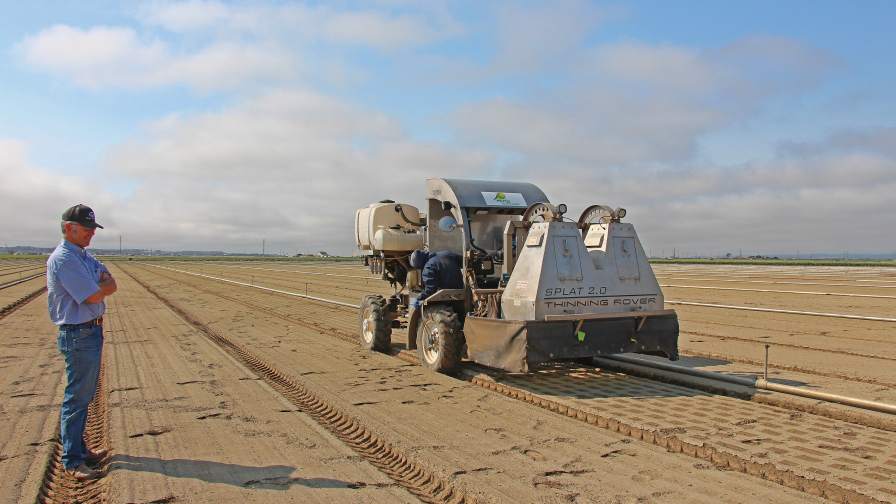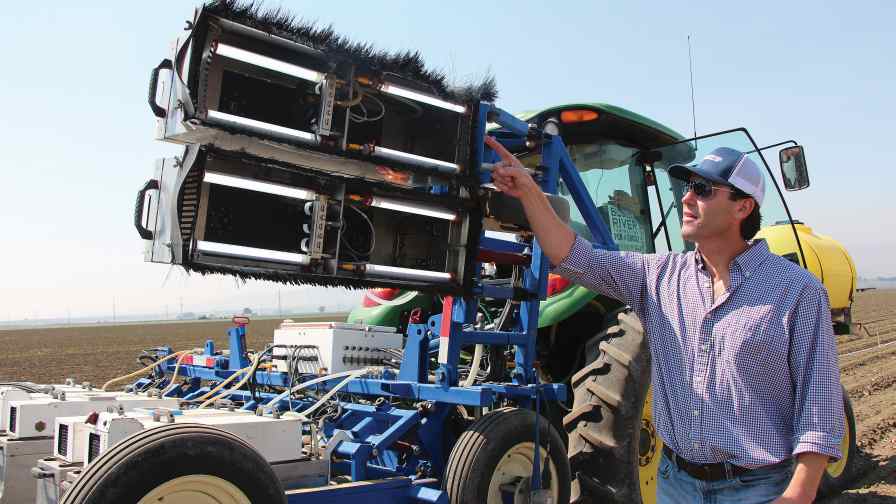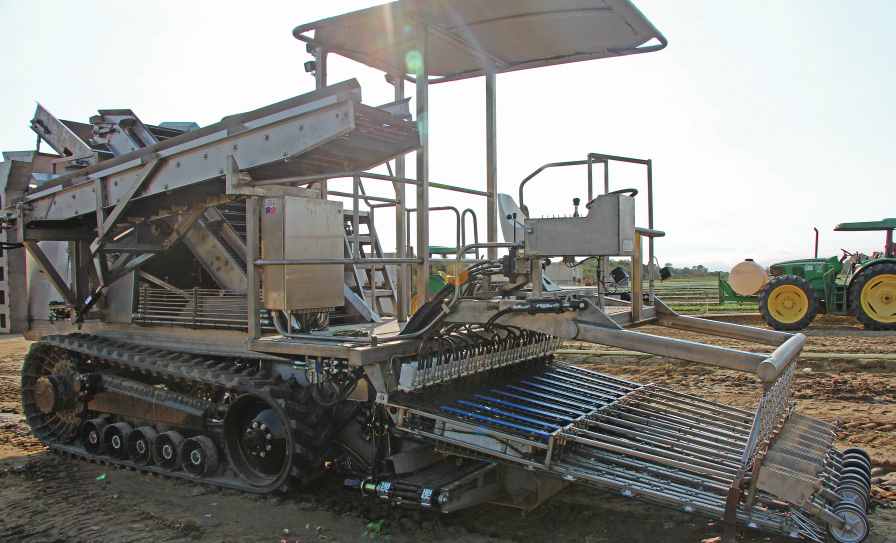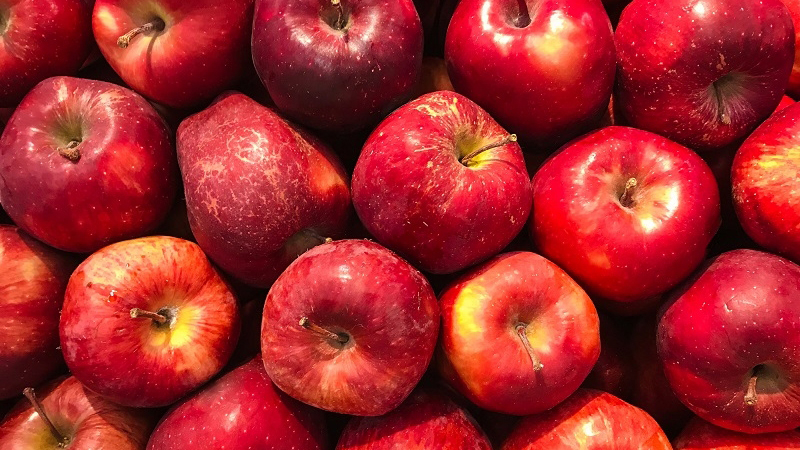Options In Lettuce Thinning

Tony Alameda of TopFlavor Farms looks on as the Thinning Rover thins a lettuce crop. Looking ahead, he says technology like this may make a difference for growers as California raises its minimum wage.
Photo credit: Rosemary Gordon
The words “precision agriculture” can mean different things to different people. For those producing row crops, it typically has to do with mapping and monitoring using GPS technology.
For vegetable growers, precision agriculture also can have different meanings. It can be mechanized tools that help with the automation process, such as automated lettuce thinning.
Tony Alameda of TopFlavor Farms, a producer of a variety of vegetables including lettuce, says precision ag and sustainability go hand in hand in California’s Salinas Valley.
Focusing on lettuce production, Alameda says prior to the thinning process, growers need to begin with good seed quality, and good seed coating. From there they must be concerned with the seed bed and the planter’s capability. By taking care of the plant’s health from the beginning, he says growers can use mechanized thinning for crops such as lettuce, and be financially sustainable.
Labor-Saving Lettuce Thinning
Today, several companies have thrown their hat into the precision-lettuce-thinning ring to mechanize this task, which typically is done with a hoe.
Alameda is taking advantage of this technology and employs Auto Thin machines in his lettuce fields. The initial Auto Thin unit, the 1.0, was a collaborative effort between Foothill Packing and Ramsay Highlander, he explains.
Why adopt this technology? Alameda says when it got to the point where he had to do something about his labor situation, he took note of Auto Thin. He has been using the Auto Thin technology for the past three years, and in 2014 he received the PrecisionAg Institute Award of Excellence.
With the help of vision technology, he says the Auto Thin machine, called the Thinning Rover, sprays a solution that will kill the plants that are to be thinned, and also has the capability to home in on the plants to be kept and treat them with a nutrient, insecticide, and/or fungicide.
High-Tech Advancements
And the technology continues to improve. “The initial 1.0 has morphed — with the help of Mantis Ag Technology — into 2.0, 3.0, and maybe a 4.0,” Alameda says. “Computer programs are different with new, more exacting spray nozzles and better camera technology. The latest is a three-bed, 80-inch machine. A six-bed, 40-inch machine is being tested now that’s faster and more precise.”
Matthew Watson, who is in field operations at Mantis, says before growers get to the thinning stage, it is important they do a good job planting lettuce.
“You get out what you put into it,” Watson explains. “We look for good plant singulation and consistent spacing, not a lot of doubles.”
On The Cutting Edge
Alameda recalls his daughter’s response to the introduction of this technology. “When the Auto Thin came out, my daughter said: ‘Dad, what are all the workers going to do?’ It hasn’t quite come to that yet,” he adds with a laugh, “but we are on the cutting edge of technology when it comes to fresh produce.”
Now, however, the machines aren’t saving Alameda a lot of money, but he says that may change in the near future.
“Current dollar savings are not significant; it’s about $10 to $20 per acre cheaper,” he says. “But California’s future minimum wage of $15 per hour and overtime after eight hours will make hand thinning very expensive.”
Smart Machines

The silver modules on this thinning unit from Blue River Technology are equipped with two cameras and one bank of solenoid sprayers set up to determine the spacing between plants, explains Mac Keely, Blue River’s General Manager for Vegetables. The plant spacing follows the grower’s planter configurations.
Photo credit: Rosemary Gordon
Another company working on lettuce thinning and other precision tools is Blue River Technology in Sunnyvale, CA. Formed about two years ago, Blue River offers smart machines with vision technology. The company is currently working with lettuce growers in California’s Salinas Valley.
Also taking note of the hole in the labor pool, Blue River’s first product launch was its Lettuce Bot, focusing on lettuce thinning.
“The Lettuce Bot moves precision agriculture from the resolution of an implement width to plant by plant,” says Mac Keely, Blue River’s General Manager for Vegetables. “The Lettuce Bot looks at every plant and makes a decision based on what it sees — selecting the best plants to keep during thinning operations.”
Timing product applications to remove plants that interfere with spacing is critical to optimize the use of this technology, Keely explains. For example, the optimum time to use the machine is when plants have emerged to less than 3 inches.
To remove a plant, a nitrogen-based material is sprayed just before and after the plant the grower wants to keep. “The machine also does a lot of quality control to make sure just the plants being targeted for removal are removed,” he explains.
The brain of the operation, so to speak, is housed in a silver module attached to the back of a tractor. Each module is designed to handle one seed line and is equipped with two cameras and one bank of solenoid sprayers set up to determine the spacing between plants. The plant spacing follows the grower’s planter configurations, Keely adds.
“The first camera is looking at the field, making decisions on what to spray, and is sending that information to the sprayer. The second camera is judging the work, evaluating what has been completed, and is making adjustments if there is a problem,” he says.
The machines can thin from 3 to 5 acres per hour, depending on the configuration and field conditions.
Advanced Capabilities
The next generation machine is the See & Spray, and it will have the capability of thinning lettuce and then weeding after plant emergence, Keely adds.
“[See & Spray] utilizes an advanced technique called ‘deep learning’ that can recognize not only size and spacing of plants, but also shapes and patterns in plants,” he says. “This technique allows our machines to see the difference between lettuce plants and weeds, and then spray only the weeds. One of the biggest benefits of See & Spray is that you can target either the plant or a weed, and apply a material to remove it or apply a material to help the plant’s health and vigor. This includes applying fungicides, crop nutrients, and crop protectants.”
Part of the plan, Keely says, is to give growers the best of both worlds, being able to both manage fields on a plant-by-plant basis and on a large scale.
“We can make the grower’s life easier,” he says. “But in the end, if we are to be successful, we can change the way each plant is managed.”
New Harvester For Radishes

A new track harvester from Valley Fabrication can enter fields in all conditions to cleanly remove radishes with or without the leafy top.
Photo credit: Rosemary Gordon
Tony Alameda of TopFlavor Farms, with locations in Salinas, CA, and Yuma, AZ, produces an array of lettuces, broccoli, cauliflower, celery, radish, cilantro, parsley, beets, leeks, Napa cabbage, kale,
and spinach.
Alameda says the majority of specialty items are produced with TopFlavor’s partners at Sabor Farms, which was founded in 2006. “Sabor Farms is the provider of specialty vegetables to many of the shippers in the Salinas Valley,” he adds.
The specialty items include the baby leaf crops and the most recent endeavor is radish production. To help with harvesting the radishes, a new stainless-steel harvester from Valley Fabrication was constructed. The machine design was in the works for two years.
“The new track harvester will allow Sabor to enter fields under all conditions, cleanly remove radishes with or without the leafy top, and quickly place product in bins that will head toward the packing shed,” he says.
The machine made its debut in September and the performance of the new harvester is still being refined.
With California’s challenging labor situation, Alameda says Sabor Farms is anticipating mechanization will be paramount to the future of many of its locally produced crops. Right now, half of all radishes grown for Sabor are harvested by hand.










